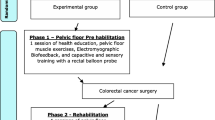Abstract
The objective of this study was to study the effect of early pelvic floor re-education on the degree and duration of incontinence and to evaluate the results of radical retropubic prostatectomy (RRP) performed in a non-teaching hospital. This is a non-randomised study. From March 2000 to November 2003, 57 consecutive men, who underwent RRP for localized prostate cancer, participated in a pelvic floor re-educating program. Continence was defined as a loss of no more than 2-g urine on the 24-h pad test and no use of pads. The 24-h pad test was performed once in every 4 weeks until the patient indicated that he was continent. Diurnal and nocturnal continence was achieved after 1, 2, 3, 6 and 12 months post catheter removal in 40, 49, 70, 86 and 88% of all men, respectively. Comparison of our results with current literature suggest that the time period towards continence after a RRP can be shortened relevantly if pelvic floor re-education is started directly after catheter removal.
Similar content being viewed by others
References
Narayan P, Konety B, Aslam K, Aboseif S, Blumenfeld W, Tanagho E (1995) Neuroanatomy of the external urethral sfincter: implications for urinary continence preservation during radical prostate surgery. J Urol 153:337–341
Talcott JA, Rieker P, Propert KJ, Clark JA, Wishnow KI, Loughlin KR, Richie JP, Kantoff P (1997) Patient-reported impotence and incontinence after nerve sparing radical prostatectomy. J Natl Cancer Inst 89:1117–1123
Carlson KV, Nitti VW (2001) Prevention and management of incontinence following radical prostatectomy. Urol Clin North Am 28(3):595–612
Bates TS, Wright MP, Gillatt DA (1998) Prevalence and impact of incontinence and impotence following total prostatectomy assessed anonymously by the ICS-male questionnaire. Eur Urol 38:165–169
Koch MO, Foster RS, Bell B, Beck S, Cheng L, Parekh D, Jung SH (2000) Characterization and predictors of prostate specific antigen progression rates after radical retropubic prostatectomy. J Urol 164:749–753
Franke JJ, Gilbert B, Grier J, Koch MO, Shyr Y, Smith JA (2000) Early post-prostatectomy pelvic floor biofeedback. J Urol 163:191–193
Moore KN, Griffiths D, Hughton A (1999) Urinary incontinence after radical prostatectomy: a randomized controlled trial comparing pelvic muscle exercises with or without electrical stimulation. BJU Int 83:57–65
Bales GT, Gerber GS, Minor TX, Mhoon DA, McFarland JM, Kim HL, Brendler CB (2000) Effect of preoperative biofeedback/pelvic floor training on continence in men undergoing radical prostatectomy. Urology 56:627–630
Wei JT, Dunn RL, Marcovich R, Montie JE, Sanda MG (2000) Prospective assessment of patient reported urinary continence after radical prostatectomy. J Urol 164:744–748
Kielb S, Dunn RL, Rashid MG, Murray S, Sanda MG, Montie JE, Wei JT (2001) Assessment of early continence recovery after radical prostatectomy: patient reported symptoms and impairment. J Urol 166:958–961
Wille S, Sobottka A, Heidenreich A, Hofmann R (2003) Pelvicfloor exercises, electrical stimulation and biofeedback after radical prostatectomy: results of a prospective randomised trial. J Urol 170:490–493
Van Kampen M, De Weerdt W, Van Poppel H, De Ridder D, Feys H, Baert L (2000) Effect of pelvic-floor re-education on duration and degree of incontinence after radical prostatectomy: a randomized controlled trial. Lancet 335:98–102
Parekh AR, Feng MI, Kirages D, Bremner H, Kaswick J, Aboseif S (2003) The role of pelvic floor exercises on post-prostatectomy incontinence. J Urol 170:130–133
Begg CB, Riedel ER, Bach PB, Kattan MW, Schrag D, Warren JL, Scardino PT (2002) Variations in morbidity after radical prostatectomy. New Engl J Med 346:1138–1144
Van Poppel H, Collette L, Kirkali Z, Brausi M, Hoekstra W, Newling DW, Decoster and members of the EORTC GU Group (2001) Quality control of radical prostatectomy: a feasibility study. Eur J Cancer 37:884–891
Lepor H, Nieder AM, Ferrandino MN (2001) Intraoperative and postoperative complications of radical retropubic prostatectomy in a consecutive series of 1,000 cases. J Urol 166:1729–1733
Salomon L, Levrel O, de la Taille A, Anastasiadis AG, Saint F, Zaki S, Vordos D, Cicco A, Olsson LE, Hoznek A, Chopin D, Abbou CC (2002) Radical prostatectomy by the retropubic, perineal and laparoscopic approach: 12 Years of experience in one center. Eur Urol 42:104–111
Wieder JA, Soloway MS (1998) Incidence, etiology, location, prevention and treatment of positive surgical margins after radical prostatectomy for prostate cancer. J Urol 160:299–315
Augustin H, Hammerer P, Graefen M, Palisaar J, Noldus J, Fernandez S, Huland H (2003) Intraoperative and perioperative morbidity of contemporary radical retropubic prostatectomy in a consecutive series of 1243 patients: results of a single center between 1999 and 2002. Eur Urol 43:113–118
Anastasiadis AG, Salomon L, Katz R, Hoznek A, Chopin D, Abbou CC (2003) Radical retropubic versuslaparoscopic prostatectomy: a prospective comparison of functional outcome. Urology 62:292–297
Artibani W, Grosso G, Novara G, Pecoraro G, Sidoti O, Sarti A, Ficarra V (2003) laparoscopic radical prostatectomy better than traditional retropubic radical prostatectomy? An analysis of peri-operative morbidity in two contemporary series in Italy. Eur Urol 44:410–406
Groutz A, Blaivas JG, Chaikin DC, Resnick NM, Engleman K, Anzalone D, Bryzinski B, Wein AJ (2000) Noninvasieve outcome measures of urinary incontinence and lower urinary tract symptoms: a multicenter study of micturationdiary and pad tests. J Urol 164:698–701
Author information
Authors and Affiliations
Corresponding author
Rights and permissions
About this article
Cite this article
Cornel, E.B., Wit, R.d. & Witjes, J.A. Evaluation of early pelvic floor physiotherapy on the duration and degree of urinary incontinence after radical retropubic prostatectomy in a non-teaching hospital. World J Urol 23, 353–355 (2005). https://doi.org/10.1007/s00345-005-0003-9
Received:
Accepted:
Published:
Issue Date:
DOI: https://doi.org/10.1007/s00345-005-0003-9




